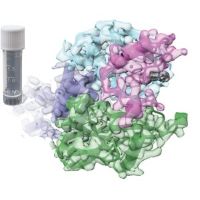Specification
| Description | Recombinant protein from the full-length sequence of Homo sapiens STIP1 homology and U-box containing protein 1 (STUB1), transcript variant 1 (NM_005861). |
| Organism | Homo sapiens (Human) |
| Expression Host | Human Cells |
| Tag Info | His or DYKDDDDK. Please contact us if you need further information or require specific designed tag. |
| Purity | Greater than 90% by SDS-PAGE gel |
| Uniprot ID | Q9UNE7 |
| Entry Name | CHIP_HUMAN |
| Gene Names | STUB1 CHIP PP1131 |
| Alternative Gene Names | CHIP |
| Alternative Protein Names | E3 ubiquitin-protein ligase CHIP (EC 2.3.2.27) (Antigen NY-CO-7) (CLL-associated antigen KW-8) (Carboxy terminus of Hsp70-interacting protein) (RING-type E3 ubiquitin transferase CHIP) (STIP1 homology and U box-containing protein 1) |
| Application | Antigens, Western, ELISA and other in vitro binding or in vivo functional assays, and protein-protein interaction studies; For research & development use only! |
| Buffer | Purified protein formulated in a sterile solution of PBS buffer, pH7.2, without any preservatives |
| Endotoxin | Endotoxin level is < 0.1 ng/µg of protein (<1EU /µg) |
| Length | 303 |
| Molecular Weight(Da) | 34856 |
| Protein Sequence | (The sequence of expressed protein may have some variation from the sequence shown below. Please contact us for the exact sequence.) MKGKEEKEGGARLGAGGGSPEKSPSAQELKEQGNRLFVGRKYPEAAACYGRAITRNPLVAVYYTNRALCYLKMQQHEQALADCRRALELDGQSVKAHFFLGQCQLEMESYDEAIANLQRAYSLAKEQRLNFGDDIPSALRIAKKKRWNSIEERRIHQESELHSYLSRLIAAERERELEECQRNHEGDEDDSHVRAQQACIEAKHDKYMADMDELFSQVDEKRKKRDIPDYLCGKISFELMREPCITPSGITYDRKDIEEHLQRVGHFDPVTRSPLTQEQLIPNLAMKEVIDAFISENGWVEDY |
Background
| Function | FUNCTION: E3 ubiquitin-protein ligase which targets misfolded chaperone substrates towards proteasomal degradation. Collaborates with ATXN3 in the degradation of misfolded chaperone substrates: ATXN3 restricting the length of ubiquitin chain attached to STUB1/CHIP substrates and preventing further chain extension. Ubiquitinates NOS1 in concert with Hsp70 and Hsp40. Modulates the activity of several chaperone complexes, including Hsp70, Hsc70 and Hsp90. Mediates transfer of non-canonical short ubiquitin chains to HSPA8 that have no effect on HSPA8 degradation. Mediates polyubiquitination of DNA polymerase beta (POLB) at 'Lys-41', 'Lys-61' and 'Lys-81', thereby playing a role in base-excision repair: catalyzes polyubiquitination by amplifying the HUWE1/ARF-BP1-dependent monoubiquitination and leading to POLB-degradation by the proteasome. Mediates polyubiquitination of CYP3A4. Ubiquitinates EPHA2 and may regulate the receptor stability and activity through proteasomal degradation. Acts as a co-chaperone for HSPA1A and HSPA1B chaperone proteins and promotes ubiquitin-mediated protein degradation (PubMed:27708256). Negatively regulates the suppressive function of regulatory T-cells (Treg) during inflammation by mediating the ubiquitination and degradation of FOXP3 in a HSPA1A/B-dependent manner (PubMed:23973223). Likely mediates polyubiquitination and downregulates plasma membrane expression of PD-L1/CD274, an immune inhibitory ligand critical for immune tolerance to self and antitumor immunity. Negatively regulates TGF-beta signaling by modulating the basal level of SMAD3 via ubiquitin-mediated degradation (PubMed:24613385). May regulate myosin assembly in striated muscles together with UBE4B and VCP/p97 by targeting myosin chaperone UNC45B for proteasomal degradation (PubMed:17369820). Mediates ubiquitination of RIPK3 leading to its subsequent proteasome-dependent degradation (PubMed:29883609). {ECO:0000269|PubMed:10330192, ECO:0000269|PubMed:11146632, ECO:0000269|PubMed:11557750, ECO:0000269|PubMed:15466472, ECO:0000269|PubMed:17369820, ECO:0000269|PubMed:19103148, ECO:0000269|PubMed:19567782, ECO:0000269|PubMed:19713937, ECO:0000269|PubMed:23973223, ECO:0000269|PubMed:23990462, ECO:0000269|PubMed:24613385, ECO:0000269|PubMed:28813410, ECO:0000269|PubMed:29883609}. |
| Pathway | Protein modification; protein ubiquitination. |
| Protein Families | |
| Tissue Specificity | Expressed in differentiated myotubes (at protein level) (PubMed:17369820). Highly expressed in skeletal muscle, heart, pancreas, brain and placenta (PubMed:10330192, PubMed:11435423). Detected in kidney, liver and lung (PubMed:10330192, PubMed:11435423). {ECO:0000269|PubMed:10330192, ECO:0000269|PubMed:11435423, ECO:0000269|PubMed:17369820}. |
QC Data
| Note | Please contact us for QC Data |
| Product Image (Reference Only) |  |

